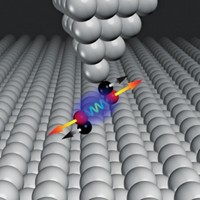Advertisement
Grab your lab coat. Let's get started
Welcome!
Welcome!
Create an account below to get 6 C&EN articles per month, receive newsletters and more - all free.
It seems this is your first time logging in online. Please enter the following information to continue.
As an ACS member you automatically get access to this site. All we need is few more details to create your reading experience.
Not you? Sign in with a different account.
Not you? Sign in with a different account.
ERROR 1
ERROR 1
ERROR 2
ERROR 2
ERROR 2
ERROR 2
ERROR 2
Password and Confirm password must match.
If you have an ACS member number, please enter it here so we can link this account to your membership. (optional)
ERROR 2
ACS values your privacy. By submitting your information, you are gaining access to C&EN and subscribing to our weekly newsletter. We use the information you provide to make your reading experience better, and we will never sell your data to third party members.
Analytical Chemistry
Picturing DNA On A Surface
Label-free method probes hybridization and chirality of bound nucleotides
by Mitch Jacoby
June 4, 2007
| A version of this story appeared in
Volume 85, Issue 23

A NEW TECHNIQUE allows researchers for the first time to determine the structure and chirality of surface-bound oligonucleotides. Based on vibrational spectroscopy, the technique provides the first direct method for observing DNA base pairing and other basic biochemical processes that occur on surfaces, and it may lead to advances in biodetection technologies and medical diagnostics.
Years of investigations have led to in-depth understanding of the chemistry that drives complementary strands of oligonucleotides to hybridize (form duplexes) in solution. The surface analogs of those reactions, however, are not well-understood, yet they are critical to a variety of DNA detection methods.
For example, DNA chips, which are widely used in genomics and in studies of diseases, rely on strands of DNA (probe molecules) that are tethered to a solid surface to form duplexes with complementary analyte strands in solution. The analyte molecules are often tagged with nanoparticles or fluorescent labels to facilitate detection. Then, after hybridization, the target labels are exploited in a subsequent step to signal the presence of the hybridized form of the analyte on the DNA chip.
Now, that detection can be carried out directly—without labels—by using a variant of sum frequency generation (SFG), a nonlinear optical process based on the interaction of two beams of light having different frequencies. Probing the reaction between thymine and adenine chains (T15 and A15) as a test case, researchers at Northwestern University have demonstrated that the SFG technique can track the molecular ordering that occurs as surface-bound molecules react to form helical duplexes (J. Am. Chem. Soc., DOI: 10.1021/ja071848r).
The research team, which includes Grace Y. Stokes, Julianne M. Gibbs-Davis, Faith C. Boman, and chemistry professors Franz M. Geiger and SonBinh T. Nguyen, also showed that the method reveals a difference in the chirality of surface-bound T15 strands hybridized with A15 and that of the duplexes formed when A15 strands tethered to a surface react with T15. The difference results from the orientation of a thymine methyl group, which varies depending on the order in which the reaction steps are carried out.
Describing the work as "interesting and stimulating," SFG pioneer Yuen-Ron Shen, an emeritus physics professor at the University of California, Berkeley, notes that, to his knowledge, this study marks the first time that the effect of conformational changes on the chirality of the secondary structure of adsorbed molecules has been monitored.
Zhan Chen, a University of Michigan, Ann Arbor, chemistry professor, says SFG is a powerful technique for elucidating the structures of biological molecules such as lipids, peptides, and proteins at interfaces. "By studying interfacial DNA, this innovative and excellent work further demonstrates that SFG has the ability to revolutionize research related to interfacial phenomena in life sciences."





Join the conversation
Contact the reporter
Submit a Letter to the Editor for publication
Engage with us on Twitter